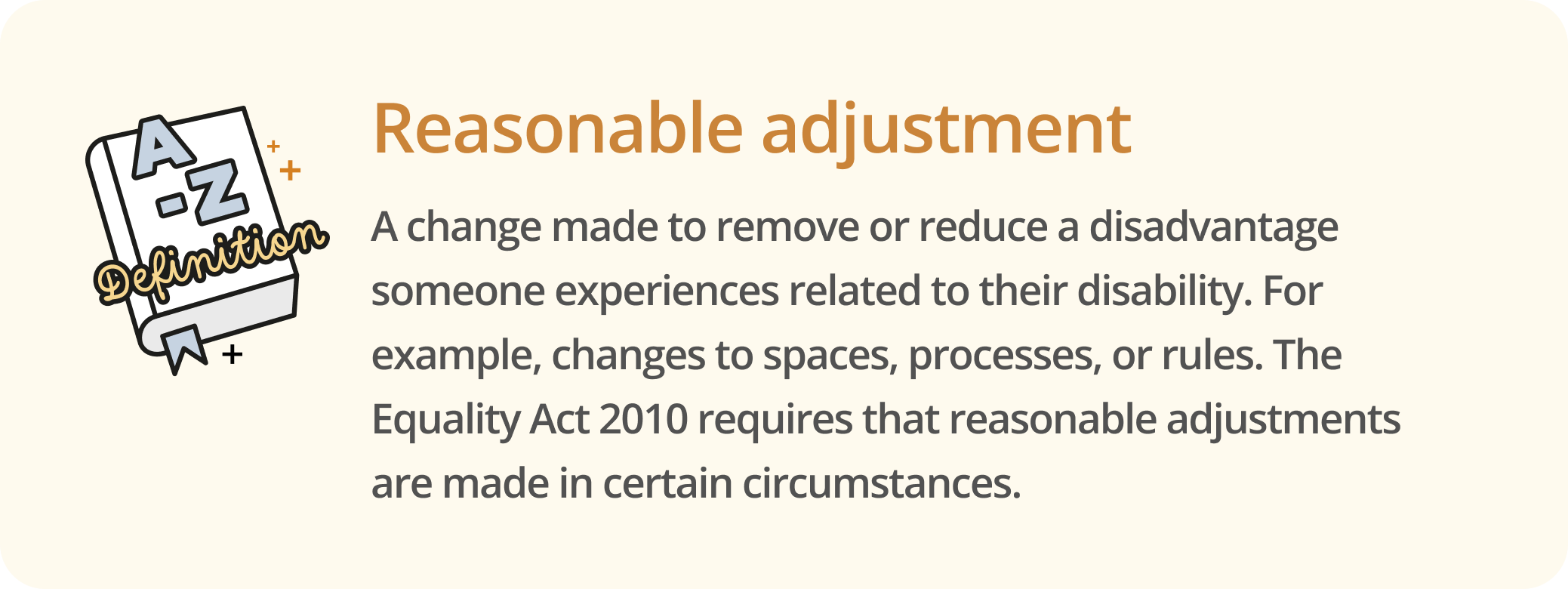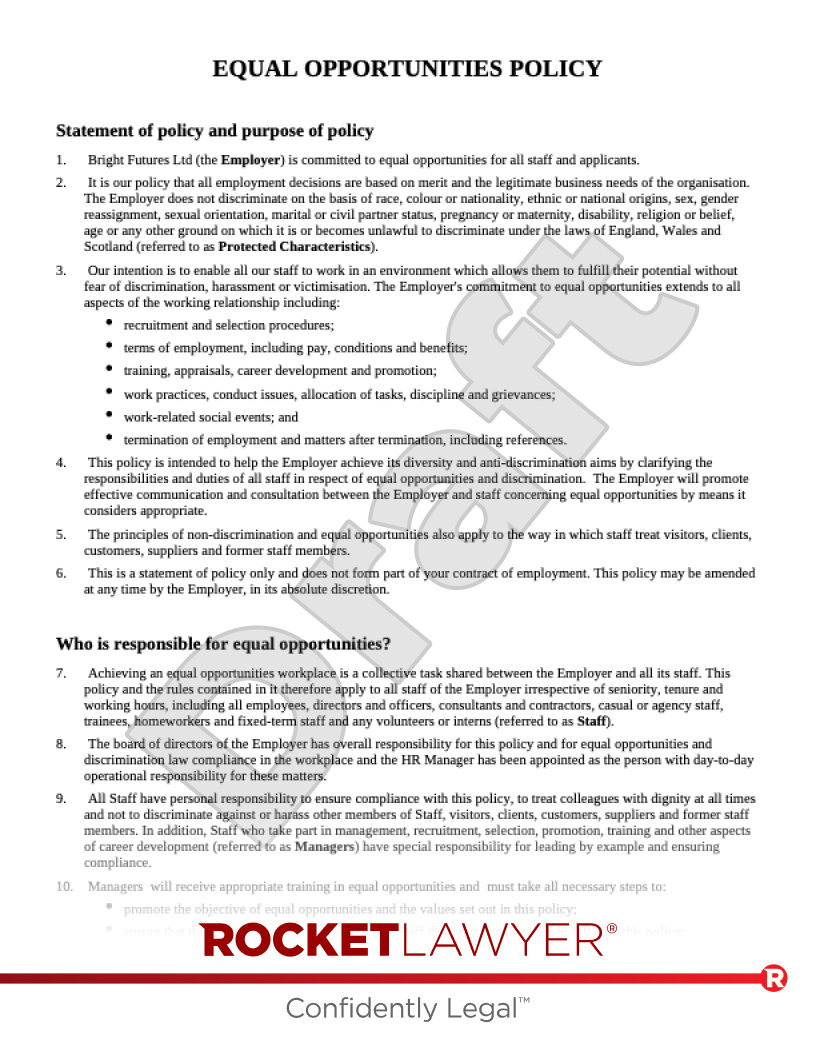What is a disability?
Under the Equality Act 2010, a disability is a physical or mental impairment that has a substantial and long-term adverse effect on the ability of a staff member to carry out normal day-to-day activities.
An ‘impairment’ is a reduction of someone’s mental or physical abilities, and can (but doesn’t have to) be caused by a medical condition or illness. A ‘substantial adverse effect’ is something that has more than a minor or trivial impact on someone’s life and how they can do certain things. This may change or fluctuate over time. Something is ‘long term’ if it will affect (or is likely to affect) someone for at least 1 year, even if a condition’s effects come and go.
While there isn’t an exhaustive list of ‘normal day-to-day activities’, they include things people do on a regular or daily basis. For example:
-
driving
-
communicating and interacting with others
-
using computers
-
following instructions
For more information, see the Government’s guidance.
Automatic disabilities
Under disability discrimination law the following conditions are automatically considered disabilities (even if they don’t affect day-to-day activities):
-
cancer
-
HIV infections
-
multiple sclerosis (MS)
-
visual impairments (ie being certified as blind, severely sight impaired, sight impaired or partially sighted)
Progressive conditions
Progressive conditions are those that get worse over time (eg Alzheimer's and Parkinson's disease). Under the law, someone with a progressive condition has a disability as soon as their progressive condition starts to have an effect on their normal day-to-day activities (provided this is long-term). The effect does not have to be substantial provided it is likely to become substantial in the future.
Other impairments or conditions
Whether a condition or impairment is a disability depends on the situation in question and, as a result, no exhaustive list of disabilities exists. Generally, employers should consider how a staff member’s impairment/condition effects them, rather than what the impairment/condition is. Open communication between employers and staff is essential, to ensure everyone understands the situation in question. However, common examples include:
-
neurodiversity (eg ADHS, dyslexia, autism) - even if someone doesn’t consider themselves to have a disability, being neurodivergent will typically be considered a disability under the law. For more information, read Neurodiversity in the workplace
-
disfigurements - severe disfigurements will generally be considered a disability as, by law, they are deemed to have a substantial adverse effect on the ability to carry out normal day-to-day activities. Less severe disfigurements, on the other hand, may not have a substantial adverse effect on someone’s ability to carry out normal day-to-day activities and may, therefore, not be a disability
-
menopause - menopause may be considered a disability as some suffer from prolonged and severe physical/mental health symptoms that have a substantial adverse effect on their ability to carry out normal day-to-day activities. You can consider making a Menopause policy to set out how it will be handled in your business. For more information, read Menopause in the workplace
The long-term effects of Coronavirus (COVID-19), commonly known as ‘long COVID’ or ‘post-COVID-19 syndrome’, may also be considered a disability for the purposes of the Equality Act. In May 2022, an employment tribunal in Scotland decided in the case Burke v Turning Point Scotland that an employee suffering from long COVID was disabled for the purposes of the Equality Act. However, whether long COVID is a disability in a given situation will depend on a person’s individual situation - it would need to meet the general criteria for a disability as set out above (including having substantial, long-term adverse effects).
Employer considerations
The law recognises that achieving equality in the workplace for anyone with a disability may mean changing the way that employment is structured. There is a duty placed on employers to make reasonable adjustments to remove barriers in the workplace and provide support.
Considering whether a staff member has a disability
When considering whether a member of staff has a disability, employers have to discount the effects of any medication, treatment or aids. The only exception is wearing glasses or contact lenses. If an employer is unsure if a staff member’s condition or impairment is a disability, they should:
-
not make assumptions about someone’s possible disability
-
speak to the staff member about the effect their condition or impairment has on their normal day-to-day activities (including what may happen if they stopped treatment or taking medication)
-
consider any medical advice made available with the staff member’s consent (eg an occupational health report recommending possible adjustments or a medical report from a GP)
-
focus on supporting the member of staff, including making reasonable adjustments
What is a reasonable adjustment?
 Reasonable adjustments are any changes made to remove or reduce any disadvantages related to a staff member’s disability when doing their job or a job applicant’s disability when applying for a position. Reasonable adjustments can be anything from a slight alteration to the employment contract or working environment to installing new features or changing more physical elements of the job. Examples include:
Reasonable adjustments are any changes made to remove or reduce any disadvantages related to a staff member’s disability when doing their job or a job applicant’s disability when applying for a position. Reasonable adjustments can be anything from a slight alteration to the employment contract or working environment to installing new features or changing more physical elements of the job. Examples include:
-
making physical changes to the workplace (eg installing a ramp to make the workplace wheelchair-accessible)
-
providing extra or specialised equipment (eg specialised keyboard for staff members with arthritis)
-
changing working arrangements (eg changing shift patterns or allowing someone to work remotely)
-
providing information in an accessible format (eg providing a sign language interpreter or providing more time during an interview for a job applicant with dyslexia)
For more examples of reasonable adjustments, see the Equality and Human Rights Commission (EHRC) guidance.
When do reasonable adjustments need to be made?
Legally, employers need to consider making reasonable adjustments when:
-
they know (or would be expected to know) that a staff member (or job applicant) has a disability
-
a staff member (or job applicant) with a disability asks for an adjustment
-
a staff member with a disability is having difficulties with their job
-
a staff member’s absence, sickness absence or delay in returning to work is related to their disability
Where the changes are reasonable, the employer must make them.
Employers must also consider reasonable adjustments for anything linked to a staff member’s disability. For example, failure to allow a visually impaired member of staff’s assistance dog into the workplace may amount to unlawful discrimination.
When is an adjustment reasonable?
This will depend on the specifics of the situation and employers need to carefully consider if an adjustment:
-
will remove or reduce the disadvantage to the individual with the disability
-
is practical and affordable
-
could harm the health and safety of others
If employers cannot afford certain reasonable adjustments, members of staff with disabilities may be able to apply for Government funding.
If an employer believes an adjustment to be unreasonable, they should:
-
speak to the staff member (or job applicant)
-
explaining why they believe the adjustment to be unreasonable, and
-
work with the staff member (or job applicant) to find a reasonable alternative
Failure to make a reasonable adjustment for a staff member (or job applicant) with a disability amounts to disability discrimination.
What is disability discrimination?
Disability is one of the ‘protected characteristics’ set out in the Equality Act 2010, which protects people against discrimination, harassment and victimisation at work. Disability discrimination is any discrimination as a result of a disability.
For discriminatory treatment to constitute disability discrimination, there must be an actual connection between a person’s disability and the actions or similar that lead to less favourable treatment. In some cases, this can be difficult to determine.
Employers must protect staff from discrimination and take steps to prevent workplace disability discrimination. If disability discrimination takes place at work, the employer and implicated individuals can be sued. Having in place an Equal opportunities policy can help protect employers in the event of a discrimination claim.
There are also exceptions to anti-discrimination laws that favour people with disabilities (eg by allowing discrimination that helps rectify the disadvantages they face).
For more information, read Equal opportunities and discrimination.




